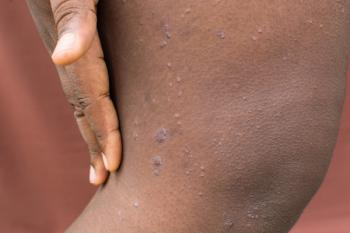
Health Discrepancies in Criminal Justice System Intrinsically Tied to Public Health
Research on the state of health care, health outcomes, and health inequities in the criminal justice system continually advocates for structural-level reform and the recognition that carceral health issues are in fact public health issues.
In 2010, HHS deemed incarceration to be a social determinant of health. Incarcerated individuals have long endured health inequities perpetuated by the federal prison system. The phenomenon of mass incarceration throughout the US has exacerbated these inequities further as the imprisoned population in the US is now the largest in the world. Despite the US having less than 5% of the global population, incarcerated individuals in this country make up 20% of the global incarcerated population, according to a recent literature review by David H. Cloud, PhD, of the University of California, San Francisco, and coauthors.1 Furthermore, an analysis by Christopher Wildeman, PhD, of Duke University, and Emily Wang, MD, MAS, of Yale University, published in 2017, revealed that between 1981 and 2005, throughout 21 wealthy, democratic countries, the US was the only nation to have a significantly negative correlation between incarceration and life expectancy.2
To date, incarcerated individuals have demonstrated increased vulnerability to infectious diseases, noncommunicable diseases, sexually transmitted infections (STIs), cardiovascular disease, hypertension, and more. And as health inequities are perpetuated throughout carceral systems, respiratory infections in particular can be transmitted to visitors, staff, and, as a result of travel beyond the prison grounds, the surrounding community. It may be easy to think of prisons as isolated or separated from society; however, how these institutions are operated can create consequences that extend to the communities and people who reside outside prison grounds. The sheer population of incarcerated individuals throughout the US, the policies they are subjected to, and the structural makeup of prisons carry bigger implications for the state of public health.1
These implications were further highlighted by the COVID-19 pandemic. COVID-19 altered the scope of health care, including the rise of telehealth usage and advocacy for better disease-prevention methods, but it also emphasized an important aspect of the US prison system: The model and design of these institutions can exacerbate public health crises. There have been numerous COVID-19 outbreaks in prison systems since the onset of the pandemic. As Cloud et al write, the incidence rates of COVID-19 throughout these institutions were 3.3 times higher than in the general population in the first pandemic year. Incarcerated individuals died at a rate 2.5 times higher than the general public. By May 2020, it was estimated that more than 200,000 prison staff members and 600,000 inmates had contracted COVID-19.1
How does incarceration exacerbate these inequities?
Communicable Disease
Poor ventilation is a systemic driver of health disparities in carceral institutions. Ventilation is an important factor to consider because the circulation of new or recycled air can improve or worsen the spread of communicable disease.1 For example, an analysis by Rachel Sklar, of the University of California, San Francisco, and colleagues empirically measured the ventilation rates in 6 California carceral institutions. They identified lower ventilation rates (69.9 cubic feet per minute [CFM]/person) compared with the standards set by the World Health Organization (WHO), which suggests a minimum 127 CFM/person. This was especially true in the winter while heating systems were set to recirculation modes, which would repurpose the air already circulating through the building, increasing the potential for disease transmission from infected individuals. Doors to housing facilities also remained closed in the winter months to conserve heat; however, this limited the capacity for fresh air to enter. The authors note that improving ventilation is a “basic step in mitigating health risks” in these facilities. While their assessment was conducted in the context of COVID-19 transmissibility, they indicate how addressing insufficient ventilation can limit the transmission of other prevalent airborne diseases such as tuberculosis. Tuberculosis, Cloud et al highlight, affects incarcerated individuals at rates 12 times higher than the general population. Very little data have been gathered regarding ventilation in carceral facilities. Therefore, focusing efforts in this area to revitalize these buildings—many of which are of older construction—could create better policies or control strategies for minimizing outbreaks within and beyond carceral institutions.3
Substance use, sexual contact, and tattooing in prison can expose people to bodily fluids and increase risks for contracting diseases such as hepatitis C and STIs. A 2016 report on the state of health in US state prisons revealed that nearly 1 in 10 (9.5%) of incarcerated individuals in state prisons have contracted hepatitis C at one point, which is over 5 times higher than the incidence in the general public (1.7%). While this disease is very treatable, the report also noted that 80% of these individuals who had ever received a diagnosis are still enduring the disease, “reflecting the unwillingness of state prison systems to provide appropriate treatment, even at the expense of public health,” Leah Wang wrote in a 2022 press release from the Prison Policy Initiative, adding, “Hepatitis C in state prisons is a failure of state policy.”4 She referenced surveys from the last decade indicating that only 16% of prisons test for hepatitis C during admission and that less than 1% of individuals with a known infection were receiving treatment. In some cases, no treatment is administered until an individual’s condition progresses.4
Furthermore, 1.1% of the incarcerated population has a history of HIV/AIDS, which is nearly triple the rate experienced in the general population in the US (0.4%). A 2023 Prison Policy Initiative briefing by Emily Widra explored the policy shortcomings that shed light on this discrepancy.5 She detailed how routine medical care for incarcerated individuals includes the option for HIV testing in only 18 states. Of 50 carceral systems surveyed, 10 reported that HIV tests were administered only if individuals requested them (“opt-in” testing). While the majority of carceral systems administer “opt-out” or mandatory HIV testing, various states and the Federal Bureau of Prisons—the largest carceral system in the US—will grant requests for HIV testing only if someone has experienced an “incident” or is otherwise considered vulnerable to HIV. Additionally, Texas is the only state to require HIV testing before an individual’s release and only 9 other states give discharged individuals the option for testing.5
Considering this data, WHO has advocated for policy-level changes to address the heightened prevalence of these diseases in carceral environments. In addition to implementing better testing practices, these amendments include harm reduction programs to provide safer access to needles or syringes and grant access to preexposure prophylaxis (PrEP) medication for HIV, postexposure prophylaxis (PEP) medication for STIs and HIV, as well as lubricants and condoms6—the latter of which are banned in many facilities.1
Noncommunicable Disease
Many noncommunicable diseases disproportionately affect incarcerated individuals. Asthma is reportedly more than twice as prevalent in this community compared with US adults in the general population (17% vs 8%).4 Furthermore, previous analyses have demonstrated that incarcerated individuals have increased odds of hypertension (OR, 1.17; 95% CI, 1.09-1.27), arthritis (OR, 1.66; 95% CI, 1.54-1.80), and some cancers such as cervical cancer (OR, 4.82; 95% CI, 3.74-6.22).7
For those with predispositions to certain health issues, incarceration can trigger or exacerbate individual risks due to factors such as access to physical activity, substance use, or diet. Additionally, carceral facilities create additional risk factors that perpetuate these outcomes stemming from the chronic stress associated with carceral environments and possible exposure to violence or trauma. For example, Cloud et al cited a 2019 investigation revealing that hypertension can be influenced by experience in solitary confinement.1
The prison diet has been a large focus of study over the years due to its associations with chronic health conditions. In a 2017 Prison Policy Initiative report, Wendy Sawyer detailed violations of healthy nutrition guidelines that occurred at the Washington State Department of Corrections. This report showed that incarcerated individuals in Washington did not have diets that met minimum requirements for vegetables, fruits, lean protein, milk, or whole grains. Instead, their diets were more heavily saturated with sodium, added sugar, and refined starches. Sawyer cited other research on prison food that demonstrated how the circumstances in Washington were not unique. Of this research, an analysis out of Georgia showed that inmates were consistently receiving a diet that was too high in saturated fat, sodium, and cholesterol while failing to meet recommendations for fiber or other micronutrients. Analyses in South Carolina and Michigan revealed similar findings, with Michigan’s report citing that portions were also a notable issue. As many of these components are knowingly associated with heightened risks for cardiovascular disease, Sawyer wrote, “Administrators looking to save a few cents per meal have traded a healthy food service program for processed foods that make incarcerated people sick.” These realities make prison food a public health concern as the long-term impacts on individual morbidity, mortality, burden on the health care system, and burden of health care costs are yet to be sufficiently studied.8
Moving Forward
Infectious and noncommunicable diseases alike have consistently affected incarcerated individuals at disproportionate rates. While advocates and researchers call attention to the structural issues of these facilities and how their conditions proliferate these inequities, one of the main lingering obstacles concerns the sheer number of incarcerated people. The impact of the COVID-19 pandemic on these facilities further elucidated how mass incarceration is a driver of these health disparities. The stress of congregate living, financial burden of providing adequate facilities, ventilation, and diets as well as the transmissibility of various diseases are all exacerbated by increasing prison populations. Since 1970, the population of incarcerated individuals has increased by 500%.9
“There is a dire need for legislative reforms that repeal existing barriers and create robust mechanisms for shedding light on the horrific conditions that persist behind prison walls, holding those in power accountable for mistreatment and abuse and facilitating public conversations about the urgency of decarceration and closures of prisons whose conditions and practices compromise the health and safety of the people they confine,” Cloud et al wrote.1
Addressing the public health issues that arise from mass incarceration and carceral conditions is no small task and cannot be done overnight; however, these problems constitute an important venture for the present and future state of public health.
REFERENCES
1. Cloud DH, Garcia-Grossman IR, Armstrong A, Williams B. Public health and prisons: priorities in the age of mass incarceration. Annu Rev Public Health. 2023;44:407-428. doi:10.1146/annurev-publhealth-071521-034016
2. Wildeman C, Wang EA. Mass incarceration, public health, and widening inequality in the USA. Lancet. 2017;389(10077):1464-1474. doi:10.1016/S0140-6736(17)30259-3
3. Sklar R, Noth E, Kwan A, Sear D, Bertozzi S. Ventilation conditions during COVID-19 outbreaks in six California state carceral institutions. PLoS One. 2023;18(11):e0293533. doi:10.1371/journal.pone.0293533
4. Wang L. Chronic punishment: the unmet health needs of people in state prisons. News release. Prison Policy. June 2022. Accessed January 26, 2024. https://www.prisonpolicy.org/reports/chronicpunishment.html
5. Widra E. New data on HIV in prisons during the COVID-19 pandemic underscore links between HIV and incarceration. News release. Prison Policy. June 1, 2023. Accessed January 26, 2024. https://www.prisonpolicy.org/blog/2023/06/01/hiv_in_prisons/
6. World Health Organization. Global HIV, hepatitis and STIs programmes: People in prisons and other closed settings. 2022. Accessed January 26, 2024. https://www.who.int/teams/global-hiv-hepatitis-and-stis-programmes/populations/people-in-prisons
7. Binswanger IA, Krueger PM, Steiner JF. Prevalence of chronic medical conditions among jail and prison inmates in the USA compared with the general population. J Epidemiol Community Health. 2009;63(11):912-919. doi:10.1136/jech.2009.090662
8. Sawyer W. Food for thought: prison food is a public health problem. Prison Policy. March 3, 2017. Accessed January 29, 2024. https://www.prisonpolicy.org/blog/2017/03/03/prison-food/
9. Smart justice: mass incarceration. ACLU. Accessed January 29, 2024. https://www.aclu.org/issues/smart-justice/mass-incarceration#:~:text=Since%201970%2C%20our%20incarcerated%20population,of%20every%2017%20white%20boys
Newsletter
Stay ahead of policy, cost, and value—subscribe to AJMC for expert insights at the intersection of clinical care and health economics.








































